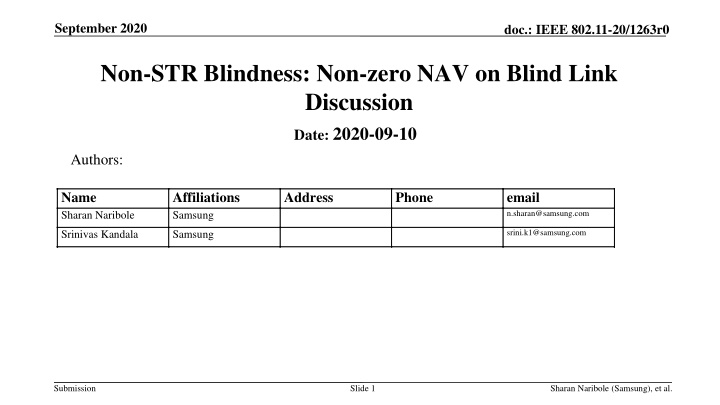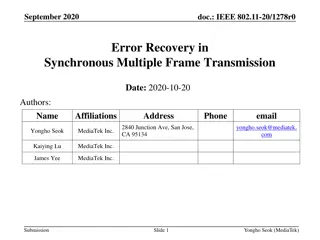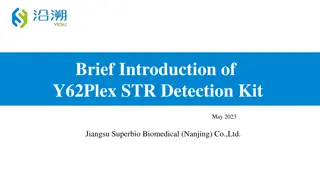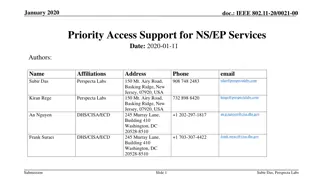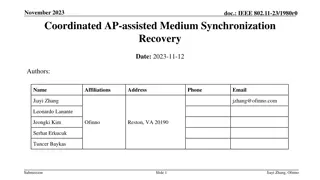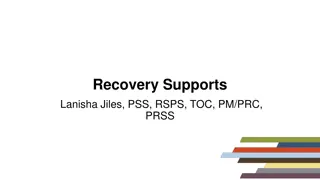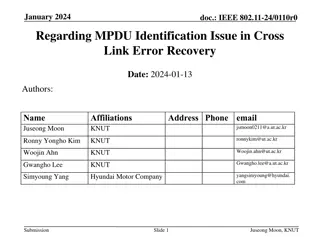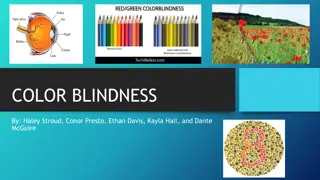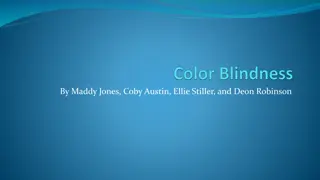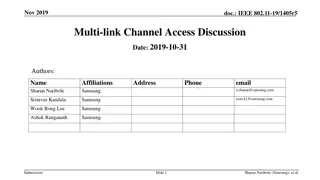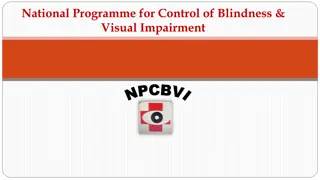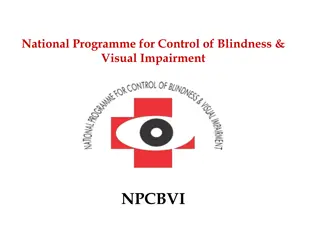Non-STR Blindness Recovery Mechanisms in IEEE 802.11 Networks
Addressing the issue of non-STR Medium Access Level Dependency (MLD) blindness in IEEE 802.11 networks, this document discusses recovery mechanisms to minimize collisions and improve performance. Proposals focus on restricting MLD's medium access on blind links and implementing recovery strategies after transmission ends.
Download Presentation

Please find below an Image/Link to download the presentation.
The content on the website is provided AS IS for your information and personal use only. It may not be sold, licensed, or shared on other websites without obtaining consent from the author.If you encounter any issues during the download, it is possible that the publisher has removed the file from their server.
You are allowed to download the files provided on this website for personal or commercial use, subject to the condition that they are used lawfully. All files are the property of their respective owners.
The content on the website is provided AS IS for your information and personal use only. It may not be sold, licensed, or shared on other websites without obtaining consent from the author.
E N D
Presentation Transcript
September 2020 doc.: IEEE 802.11-20/1263r0 Non-STR Blindness: Non-zero NAV on Blind Link Discussion Date:2020-09-10 Authors: Name Sharan Naribole Affiliations Samsung Address Phone email n.sharan@samsung.com srini.k1@samsung.com Srinivas Kandala Samsung Submission Slide 1 Sharan Naribole (Samsung), et al.
September 2020 doc.: IEEE 802.11-20/1263r0 Non-STR Blindness Background When non-STR MLD is transmitting on a link, it may not be able to listen to transmissions on other link and update its NAV After its transmission ends, it may not detect ongoing transmission on the other link. If the non-STR MLD transmits, it can lead to collision impacting its own performance and other devices performance as well o This includes legacy devices as well as EHT STAs on the multiple links used by the non-STR MLD This scenario is expected to occur frequently and is a serious issue to be addresses Several contributions highlighted this issue and suggested mechanisms [1, 2, 3, 4] We refer to Link B in example as blind link . Same terminology used in rest of the slides. Submission Slide 2 Sharan Naribole (Samsung), et al.
September 2020 doc.: IEEE 802.11-20/1263r0 Non-STR Blindness Related Work High level concept to address Blindness issue is to restrict non-STR MLD s medium access on blind link for a certain timer. At the same time, completely preventing medium access on blind link would be too strict and lead to non-STR MLD s performance degradation if the blind link was idle during timer countdown. Proposals o o AP-assisted approach wherein recovery initiated only if AP indicates busy [1. 2. 4] Ad-hoc mechanism(s) to be performed by non-STR MLD without AP assistance [3, 5] General consensus is to focus in R1 is on ad-hoc mechanism at non-STR MLD Submission Slide 3 Sharan Naribole (Samsung), et al.
September 2020 doc.: IEEE 802.11-20/1263r0 Non-STR Blindness Recovery Objective: To not eliminate medium access entirely but sufficient restrictions to minimize collisions. After transmission ends on a link, non-STR MLD begins Blindness recovery on blind link. For Medium Sync Delay timer period, non-STR MLD performs EDCA with following restrictions [4] o With a lower TBD energy detection threshold mostly in dense WLAN environments o Mandatory RTS to initiate TXOP o Limit the number of RTS (at least 1) that can be initiated and other conditions Submission Slide 4 Sharan Naribole (Samsung), et al.
September 2020 doc.: IEEE 802.11-20/1263r0 Skip Blindness Recovery if non-zero NAV on Blind Link In [4], the authors proposed exception to non-STR MLD entering Blindness Recovery phase if the non-STR MLD has a non-zero NAV on the blind link at the start of Blindness recovery Submission Slide 5 Sharan Naribole (Samsung), et al.
September 2020 doc.: IEEE 802.11-20/1263r0 Non-zero NAV Blindness Recovery Problem Scenario 1 Non-STR MLD may set NAV due to OBSS frame received on a link before entering blindness phase. During Blindness, non-STR MLD misses an intra-BSS transmission. If we skip Blindness recovery, it will lead to an intra-BSS collision and degrade performance. Without blindness recovery, non-STR MLD may send data directly or multiple RTS frames. Submission Slide 6 Sharan Naribole (Samsung), et al.
September 2020 doc.: IEEE 802.11-20/1263r0 Non-zero NAV Blindness Recovery Problem Scenario 1 Option 1 o Blindness Recovery shall still be performed by non-STR MLD even if NAV is non-zero Option 2 o Blindness Recovery shall be performed if the non-zero NAV corresponds to an OBSS frame reception. The problem in previous slide will be addressed. o Blindness Recovery may be skipped if the non-zero NAV corresponds to an intra-BSS frame reception. Submission Slide 7 Sharan Naribole (Samsung), et al.
September 2020 doc.: IEEE 802.11-20/1263r0 Non-zero NAV Blindness Recovery Problem Scenario 2 Similar to problem scenario 1 except non-zero NAV corresponds to an intra-BSS reception Solution o Combined with problem scenario 1, do not allow Blindness Recovery to be skipped if NAV is non-zero Offline feedback o Scenario similar to intra-PPDU power save o OBSS transmission may begin when STA goes to doze state during intra-BSS PPDU reception Background on 802.11ax intra-BSS Power Save provided in Appendix Submission Slide 8 Sharan Naribole (Samsung), et al.
September 2020 doc.: IEEE 802.11-20/1263r0 Non-zero NAV Blindness Recovery Problem Scenario 3 Intra-BSS TXOP may be extended during Blindness phase Non-STR MLD cannot update its NAV If Blindness Recovery is skipped, intra-BSS collision might occur Solution o Do not allow Blindness Recovery to be skipped if NAV is non-zero Offline feedback o TXOP extensions within a TXOP is not common in practice Submission Slide 9 Sharan Naribole (Samsung), et al.
September 2020 doc.: IEEE 802.11-20/1263r0 Non-zero NAV Blindness Recovery Options Multiple options for non-STR MLD s behavior if NAV is non-zero at start of Blindness Recovery Option 1 o Do not allow Blindness recovery to be skipped if NAV is non-zero Option 2 o Allow Blindness recovery to be skipped if intra-BSS NAV is non-zero or non-zero corresponds to an intra-BSS frame received Option 3 o Allow Blindness recovery to be skipped if NAV is non-zero Submission Slide 10 Sharan Naribole (Samsung), et al.
September 2020 doc.: IEEE 802.11-20/1263r0 Non-zero NAV Blindness Recovery Preferences Clearly, there are some problem scenarios that arise in this non-zero NAV case and have to be considered carefully Important point to remember that Blindness Recovery is a better safe than sorry mechanism to minimize collisions. At the same time, it does not completely eliminate the medium access of non-STR MLD during the Blindness Recovery. Using restricted conditons, non-STR MLD may still attempt initiate TXOP Therefore, our preference is either Option 1 or at least Option 2 Submission Slide 11 Sharan Naribole (Samsung), et al.
September 2020 doc.: IEEE 802.11-20/1263r0 Summary Non-STR Blindness is a serious problem that can degrade performance of not just the non-STR MLD but also its neighboring devices on multiple bands We focused on the case where non-STR MLD is unable to update its NAV on the blind link during Blindness phase and has a non-zero NAV corresponding to a frame received before entering the blindness phase on the blind link Presented multiple problem scenarios that arise if non-STR MLD is permitted to skip the Blindness Recovery due to non-zero NAV Presented possible choices to consider for addressing the highlighted problem scenarios Submission Slide 12 Sharan Naribole (Samsung), et al.
September 2020 doc.: IEEE 802.11-20/1263r0 Appendix: 802.11ax Intra-PPDU Power Save Intra-PPDU power save is the power save mechanism for an HE STA to enter the doze state or become unavailable until the end of a received PPDU that is identified as an intra-BSS PPDU. A non-AP HE STA that is in intra-PPDU power save mode may enter the doze state or become unavailable until the end of intra-BSS PPDU currently being received if one of the following conditions is met: o HE MU PPDU with STA ID different from that of STA, Uplink Flag set to 1, etc. A non-AP HE STA that is in intra-PPDU power save mode and has entered doze state or has become unavailable shall continue to operate its NAV timers and consider the medium busy and shall transition to the awake state at the end of the PPDU. Submission Slide 13 Sharan Naribole (Samsung), et al.
September 2020 doc.: IEEE 802.11-20/1263r0 References [1] 11-19/1405, Multi-link Channel Access Discussion [2] 11-20/82, Synchronous Transmitter Medium State Information [3] 11-20/490, Multi-link hidden terminal [4] 11-20/613, AP assisted non-STR behavior [5] 11-20/1009, Multi-link hidden terminal follow-up Submission Slide 14 Sharan Naribole (Samsung), et al.
